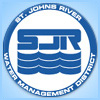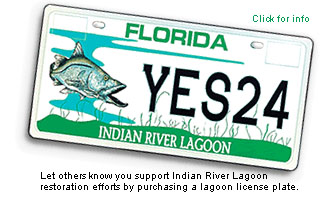 Without a second thought, we get up in the morning, turn on the faucet and fresh, clean water comes out. The St. Johns River Water Management District (SJRWMD) is the group that makes all that happen for the residents of the 18 Florida counties it oversees. Only in crisis does the average person even think about it, yet water issues are serious business.
Without a second thought, we get up in the morning, turn on the faucet and fresh, clean water comes out. The St. Johns River Water Management District (SJRWMD) is the group that makes all that happen for the residents of the 18 Florida counties it oversees. Only in crisis does the average person even think about it, yet water issues are serious business.
Ed Garland is the Regional Outreach Coordinator for the St. Johns River Water Management District. Concerned with Brevard’s (and the state’s) water issues, GreenBrevard met up with Ed to discuss where we are headed.
The St. Johns River Water Management District mission includes:
Water Supply
To implement a regional strategy to provide sufficient water for users and the environment
Surface water resource protection
To protect surface water resources of the District and improve those resources within SWIM basins and the Upper St. Johns River Basin within established deadlines
Flood protection
To prevent increases in flooding and operate and maintain the District’s regional flood control projects
Organizational effectiveness
To provide for organizational structure and tools that result in and reward continuous improvement and enhanced service delivery
Tell us about your mission
We will ensure the sustainable use and protection of water resources for the benefit of the people of the District and the state of Florida.
Of the items above the mission that has been at the forefront is water supply planning. The District is required to identify water supply sources that either meet or exceed the demand for at least 20 years. The planning process up updated every five years.
 What trends do you see that impacts our water supply?
What trends do you see that impacts our water supply?
We expect the population in the District to increase 67 percent by the year 2025. By that year, projected water demands in east-central Florida are expected to double.
Wow. Where will the water come from to meet those needs?
Existing groundwater supply are not expected to meet the demand. This is a serious problem because nearly all of the drinking water in the District comes from groundwater.
The only surface water being used for potable water is in Melbourne at Lake Washington and Taylor Creek Reservoir in Cocoa. Our dependence on groundwater has reached a critical point. Between 100 and 200 million gallons a day of alternative water sources are likely to be needed by 2025.
Alternative?
By alternative, I’m referring to surface water (rivers, lakes,etc.) desalination, and other sources that are not from the Floridan and shallow aquifers. We are also continuing to support conservation practices and increased use of reuse (treated wastewater) for irrigation instead of potable water. If nothing is done, the expected impacts to groundwater supplies in the region include impacts on wetlands, spring flows, saltwater intrusion in wells, and lower water pressure as the water table recedes.
The good news is that the District has identified more than 200 mgd (million gallons a day) of potential alternative water sources. We are working on many studies and working to bring utilities and government entities together in planning for the development of alternative sources. Working together, they can keep the costs down by spreading them out to a larger consumer base and eliminate competition, which spark water wars and drive costs skyward.
Working together makes much more sense. So at what point do we reach a crisis?
In the 18-county area within the District’s jurisdiction, water use has reached a critical stage. We are in a transitional period where our reliance on groundwater must be expanded to include other sources, such as seawater or the surface waters of rivers and lakes. Virtually all of the potable water used in the District comes from groundwater sources. The only alternative sources in use at this very moment are Lake Washington in Melbourne (which primarily supplies Melbourne and the beaches), and Taylor Creek Reservoir in Cocoa, which supplements the city’s well fields in Orange County, west of SR 520.
When groundwater supplies become stretched to their limit, competition arises. This has happened in the past in Florida and other places throughout the country. The District, in meeting its goal of finding affordable potable water sources to meet future demands, is working with utilities, local governments and other stakeholders to develop a regional approach of developing new water sources. This must be done to avoid competition and to spread the cost of the hundreds of millions of dollars in infrastructure needed to develop and maintain new sources of water. We’re examining all options while there’s still time.
Conservation can have dramatic impact.
Water conservation must also become a way of life. The days of cheap water are over. This alone should be an incentive for the average homeowner to find ways to use less water. The District offers a number of pamphlets and booklets that reveal simple ways to save water.
Where do we waste water most? How can homeowners help?
Did you know that more than half of the water used in the average household is spent on landscape irrigation? Imagine a world where carpets of thirsty lawns were replaced by drought-tolerant plants and native vegetation that almost never needs watering. The concept, known as Waterwise landscaping, is laid out in a free color book available at the District’s Palm Bay service center or online at www.sjrwmd.com.
 Not only is Waterwise beautiful, but it help to regionalize your yard. For example, compare a photo of a home fronted by a lawn. No embellishments, just a lawn. Can you tell where this house is located? Now, picture the same house ensconced in cacti or pecan trees or cabbage palms. Chances are, you’ll correctly guess that the house is located in the southwest, deep south, or Florida peninsula, respectively. What’s more, you could reduce your water bill by half and probably increase your property value and curbside appeal. It’s all about changing behavior.
Not only is Waterwise beautiful, but it help to regionalize your yard. For example, compare a photo of a home fronted by a lawn. No embellishments, just a lawn. Can you tell where this house is located? Now, picture the same house ensconced in cacti or pecan trees or cabbage palms. Chances are, you’ll correctly guess that the house is located in the southwest, deep south, or Florida peninsula, respectively. What’s more, you could reduce your water bill by half and probably increase your property value and curbside appeal. It’s all about changing behavior.
Water needs only continue to grow as Brevard, the region and the state develops. Ed relates that the days of cheap water are gone. As we grow, we need to factor in the impact development has and manage our resources to meet the demand. One thing we can all do is become more aware of the issue, and work to reduce our own personal water use.
In the coming months we’ll be speaking with other experts in the field, along with Ed and the St. Johns River Water Management District, to discuss landscaping and xeriscaping. I think that with a little insight and effort, we can change the way we use water, to make way for the growth that is coming. And it’s the only responsible course.
Visit the St. Johns River Water Management District’s Web site at: www.sjrwmd.com
Contact: Ed Garland, Regional Communications Coordinator
St. Johns River Water Management District
Phone: (321) 676-6612 or email : egarland@sjrwmd.com